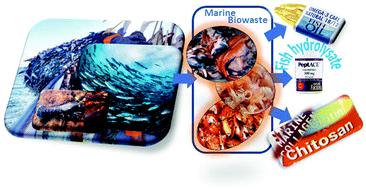当前位置:
X-MOL 学术
›
Chem. Soc. Rev.
›
论文详情
Our official English website, www.x-mol.net, welcomes your
feedback! (Note: you will need to create a separate account there.)
Upgrading of marine (fish and crustaceans) biowaste for high added-value molecules and bio(nano)-materials.
Chemical Society Reviews ( IF 40.4 ) Pub Date : 2020-06-08 , DOI: 10.1039/c9cs00653b Thomas Maschmeyer 1 , Rafael Luque 2 , Maurizio Selva 3
Chemical Society Reviews ( IF 40.4 ) Pub Date : 2020-06-08 , DOI: 10.1039/c9cs00653b Thomas Maschmeyer 1 , Rafael Luque 2 , Maurizio Selva 3
Affiliation

|
Currently, the Earth is subjected to environmental pressure of unprecedented proportions in the history of mankind. The inexorable growth of the global population and the establishment of large urban areas with increasingly higher expectations regarding the quality of life are issues demanding radically new strategies aimed to change the current model, which is still mostly based on linear economy approaches and fossil resources towards innovative standards, where both energy and daily use products and materials should be of renewable origin and ‘made to be made again’. These concepts have inspired the circular economy vision, which redefines growth through the continuous valorisation of waste generated by any production or activity in a virtuous cycle. This not only has a positive impact on the environment, but builds long-term resilience, generating business, new technologies, livelihoods and jobs. In this scenario, among the discards of anthropogenic activities, biodegradable waste represents one of the largest and highly heterogeneous portions, which includes garden and park waste, food processing and kitchen waste from households, restaurants, caterers and retail premises, and food plants, domestic and sewage waste, manure, food waste, and residues from forestry, agriculture and fisheries. Thus, this review specifically aims to survey the processes and technologies for the recovery of fish waste and its sustainable conversion to high added-value molecules and bio(nano)materials.
中文翻译:

将海洋(鱼类和甲壳类)生物废物升级为高附加值分子和生物(纳米)材料。
当前,地球正承受着人类历史上前所未有的环境压力。全球人口的不可阻挡的增长以及大城市地区的建立对生活质量的期望越来越高,这些问题需要全新的战略来改变当前的模式,这种模式仍然主要基于线性经济方法和化石资源,转向创新标准,其中能源和日常使用的产品和材料都应具有可再生来源,并且“可再次制造”。这些概念激发了循环经济愿景,通过良性循环中任何生产或活动产生的废物的持续增值来重新定义增长。这不仅对环境产生积极影响,还能建立长期的复原力,创造业务、新技术、生计和就业机会。在这种情况下,在人类活动的丢弃物中,可生物降解的废物是最大且高度异质的部分之一,其中包括花园和公园废物、来自家庭、餐馆、餐饮业和零售场所的食品加工和厨房废物,以及食品厂、家庭废物。污水废物、粪便、食品废物以及林业、农业和渔业的残留物。因此,本综述的具体目的是调查鱼类废物回收及其可持续转化为高附加值分子和生物(纳米)材料的工艺和技术。
更新日期:2020-07-06
中文翻译:

将海洋(鱼类和甲壳类)生物废物升级为高附加值分子和生物(纳米)材料。
当前,地球正承受着人类历史上前所未有的环境压力。全球人口的不可阻挡的增长以及大城市地区的建立对生活质量的期望越来越高,这些问题需要全新的战略来改变当前的模式,这种模式仍然主要基于线性经济方法和化石资源,转向创新标准,其中能源和日常使用的产品和材料都应具有可再生来源,并且“可再次制造”。这些概念激发了循环经济愿景,通过良性循环中任何生产或活动产生的废物的持续增值来重新定义增长。这不仅对环境产生积极影响,还能建立长期的复原力,创造业务、新技术、生计和就业机会。在这种情况下,在人类活动的丢弃物中,可生物降解的废物是最大且高度异质的部分之一,其中包括花园和公园废物、来自家庭、餐馆、餐饮业和零售场所的食品加工和厨房废物,以及食品厂、家庭废物。污水废物、粪便、食品废物以及林业、农业和渔业的残留物。因此,本综述的具体目的是调查鱼类废物回收及其可持续转化为高附加值分子和生物(纳米)材料的工艺和技术。











































 京公网安备 11010802027423号
京公网安备 11010802027423号